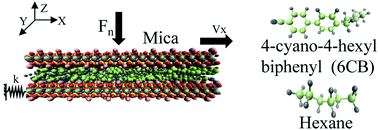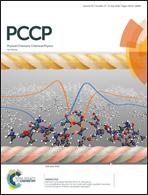Nanoscale liquid crystal lubrication controlled by surface structure and film composition†
Abstract
Liquid crystals have emerged as potential candidates for next-generation lubricants due to their tendency to exhibit long-range ordering. Here, we construct a full atomistic model of 4-cyano-4-hexylbiphenyl (6CB) nematic liquid crystal lubricants mixed with hexane and confined by mica surfaces. We explore the effect of the surface structure of mica, as well as lubricant composition and thickness, on the nanoscale friction in the system. Our results demonstrate the key role of the structure of the mica surfaces, specifically the positions of potassium (K+) ions, in determining the nature of sliding friction with monolayer lubricants, including the presence or absence of stick-slip dynamics. With the commensurate setup of confining surfaces, when the grooves created between the periodic K+ ions are parallel to the sliding direction we observe a lower friction force as compared to the perpendicular situation. Random positions of ions exhibit even smaller friction forces with respect to the previous two cases. For thicker lubrication layers the surface structure becomes less important and we observe a good agreement with the experimental data on bulk viscosity of 6CB and the additive hexane. In case of thicker lubrication layers, friction may still be controlled by tuning the relative concentrations of 6CB and hexane in the mixture.



 Please wait while we load your content...
Please wait while we load your content...